Economics of Globalization: Factors and Economic Growth Report
VerifiedAdded on 2022/09/07
|9
|1655
|20
Report
AI Summary
This report delves into the economics of globalization, focusing on economic growth and its key influencing factors. It begins with an introduction to economic growth, defining it as the increase in the value of goods and services produced by an economy, typically measured by GDP. The analysis examines the UK's economic performance, highlighting consumer spending and business investment. The report then explores several factors that impact economic growth, including natural resources, physical capital, population/labor, technology, and the legal framework. It provides specific examples, such as the impact of oil reserves on Saudi Arabia's economy and the role of technology in boosting efficiency. The conclusion summarizes the findings, emphasizing the importance of factors like technology and human capital in driving economic growth, particularly within the context of the UK economy, and references relevant academic sources.
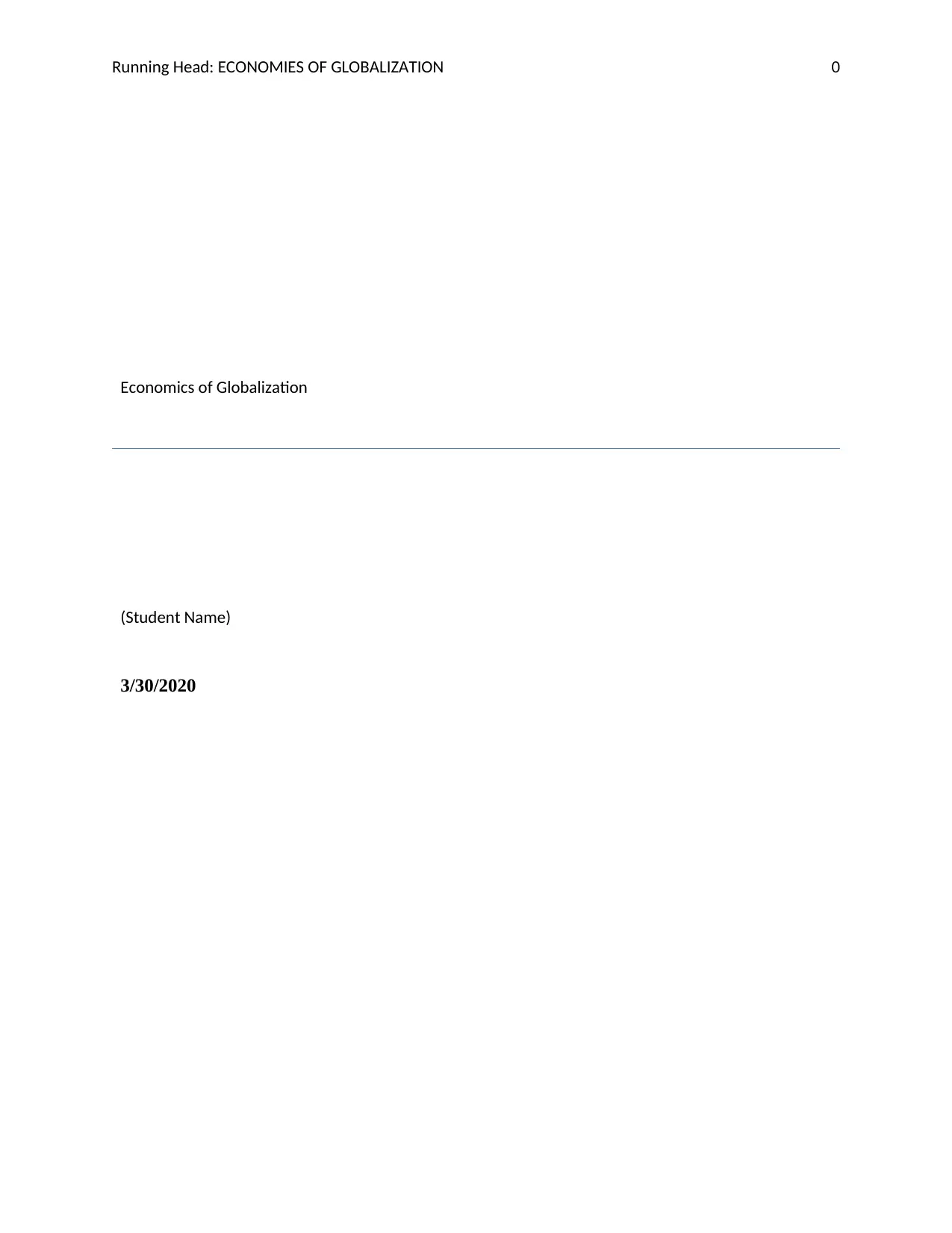
Running Head: ECONOMIES OF GLOBALIZATION 0
Economics of Globalization
(Student Name)
3/30/2020
Economics of Globalization
(Student Name)
3/30/2020
Paraphrase This Document
Need a fresh take? Get an instant paraphrase of this document with our AI Paraphraser
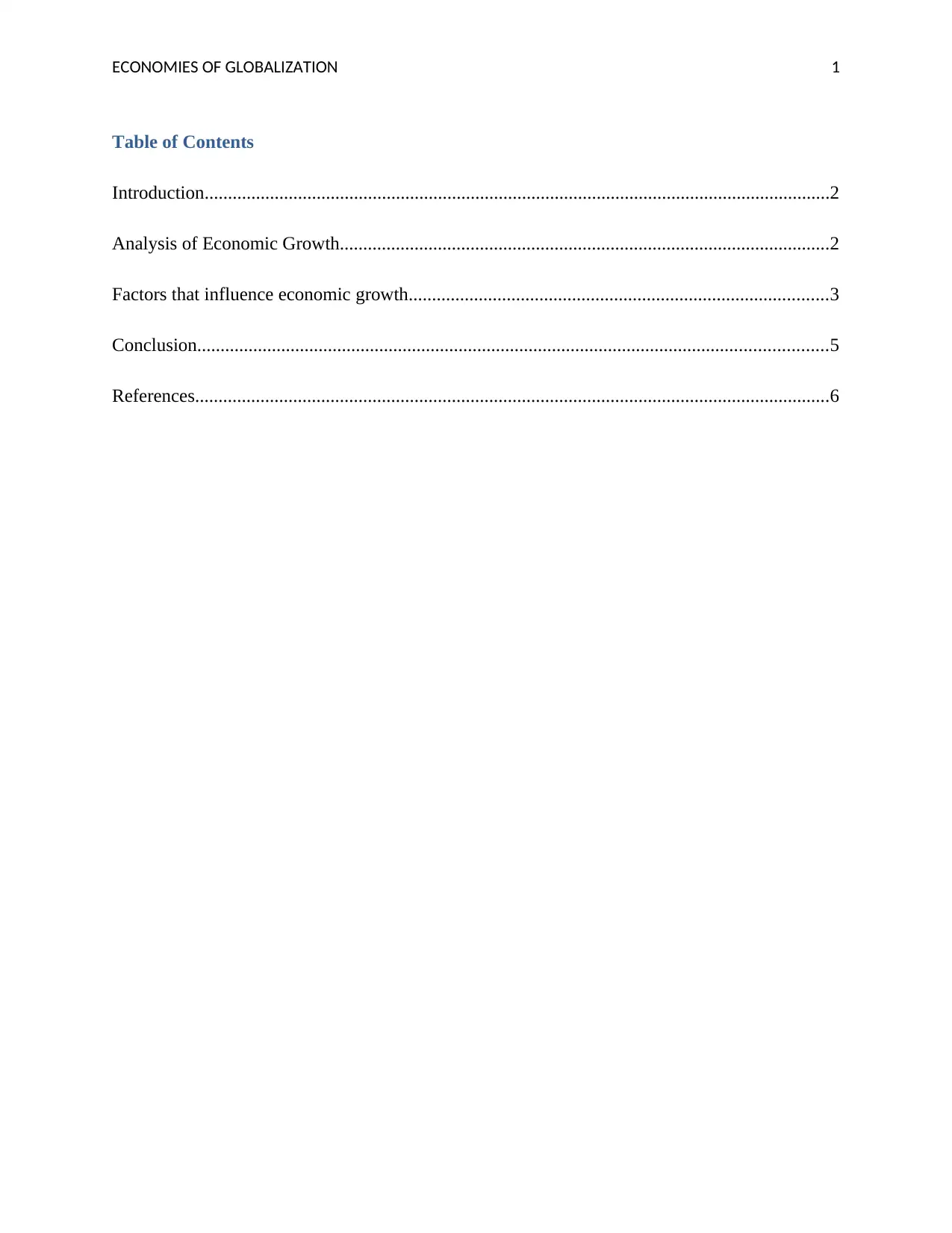
ECONOMIES OF GLOBALIZATION 1
Table of Contents
Introduction......................................................................................................................................2
Analysis of Economic Growth.........................................................................................................2
Factors that influence economic growth..........................................................................................3
Conclusion.......................................................................................................................................5
References........................................................................................................................................6
Table of Contents
Introduction......................................................................................................................................2
Analysis of Economic Growth.........................................................................................................2
Factors that influence economic growth..........................................................................................3
Conclusion.......................................................................................................................................5
References........................................................................................................................................6
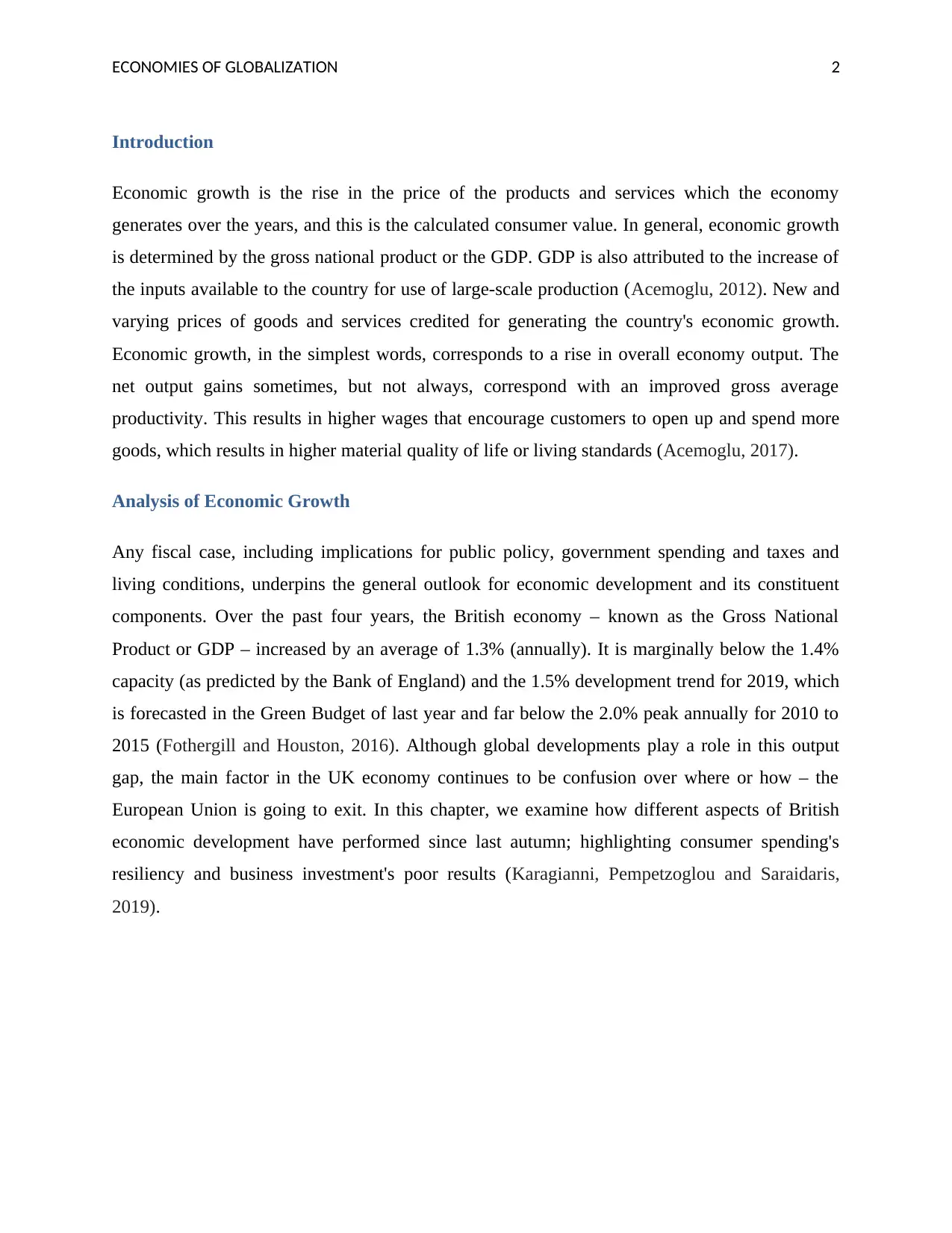
ECONOMIES OF GLOBALIZATION 2
Introduction
Economic growth is the rise in the price of the products and services which the economy
generates over the years, and this is the calculated consumer value. In general, economic growth
is determined by the gross national product or the GDP. GDP is also attributed to the increase of
the inputs available to the country for use of large-scale production (Acemoglu, 2012). New and
varying prices of goods and services credited for generating the country's economic growth.
Economic growth, in the simplest words, corresponds to a rise in overall economy output. The
net output gains sometimes, but not always, correspond with an improved gross average
productivity. This results in higher wages that encourage customers to open up and spend more
goods, which results in higher material quality of life or living standards (Acemoglu, 2017).
Analysis of Economic Growth
Any fiscal case, including implications for public policy, government spending and taxes and
living conditions, underpins the general outlook for economic development and its constituent
components. Over the past four years, the British economy – known as the Gross National
Product or GDP – increased by an average of 1.3% (annually). It is marginally below the 1.4%
capacity (as predicted by the Bank of England) and the 1.5% development trend for 2019, which
is forecasted in the Green Budget of last year and far below the 2.0% peak annually for 2010 to
2015 (Fothergill and Houston, 2016). Although global developments play a role in this output
gap, the main factor in the UK economy continues to be confusion over where or how – the
European Union is going to exit. In this chapter, we examine how different aspects of British
economic development have performed since last autumn; highlighting consumer spending's
resiliency and business investment's poor results (Karagianni, Pempetzoglou and Saraidaris,
2019).
Introduction
Economic growth is the rise in the price of the products and services which the economy
generates over the years, and this is the calculated consumer value. In general, economic growth
is determined by the gross national product or the GDP. GDP is also attributed to the increase of
the inputs available to the country for use of large-scale production (Acemoglu, 2012). New and
varying prices of goods and services credited for generating the country's economic growth.
Economic growth, in the simplest words, corresponds to a rise in overall economy output. The
net output gains sometimes, but not always, correspond with an improved gross average
productivity. This results in higher wages that encourage customers to open up and spend more
goods, which results in higher material quality of life or living standards (Acemoglu, 2017).
Analysis of Economic Growth
Any fiscal case, including implications for public policy, government spending and taxes and
living conditions, underpins the general outlook for economic development and its constituent
components. Over the past four years, the British economy – known as the Gross National
Product or GDP – increased by an average of 1.3% (annually). It is marginally below the 1.4%
capacity (as predicted by the Bank of England) and the 1.5% development trend for 2019, which
is forecasted in the Green Budget of last year and far below the 2.0% peak annually for 2010 to
2015 (Fothergill and Houston, 2016). Although global developments play a role in this output
gap, the main factor in the UK economy continues to be confusion over where or how – the
European Union is going to exit. In this chapter, we examine how different aspects of British
economic development have performed since last autumn; highlighting consumer spending's
resiliency and business investment's poor results (Karagianni, Pempetzoglou and Saraidaris,
2019).
⊘ This is a preview!⊘
Do you want full access?
Subscribe today to unlock all pages.

Trusted by 1+ million students worldwide
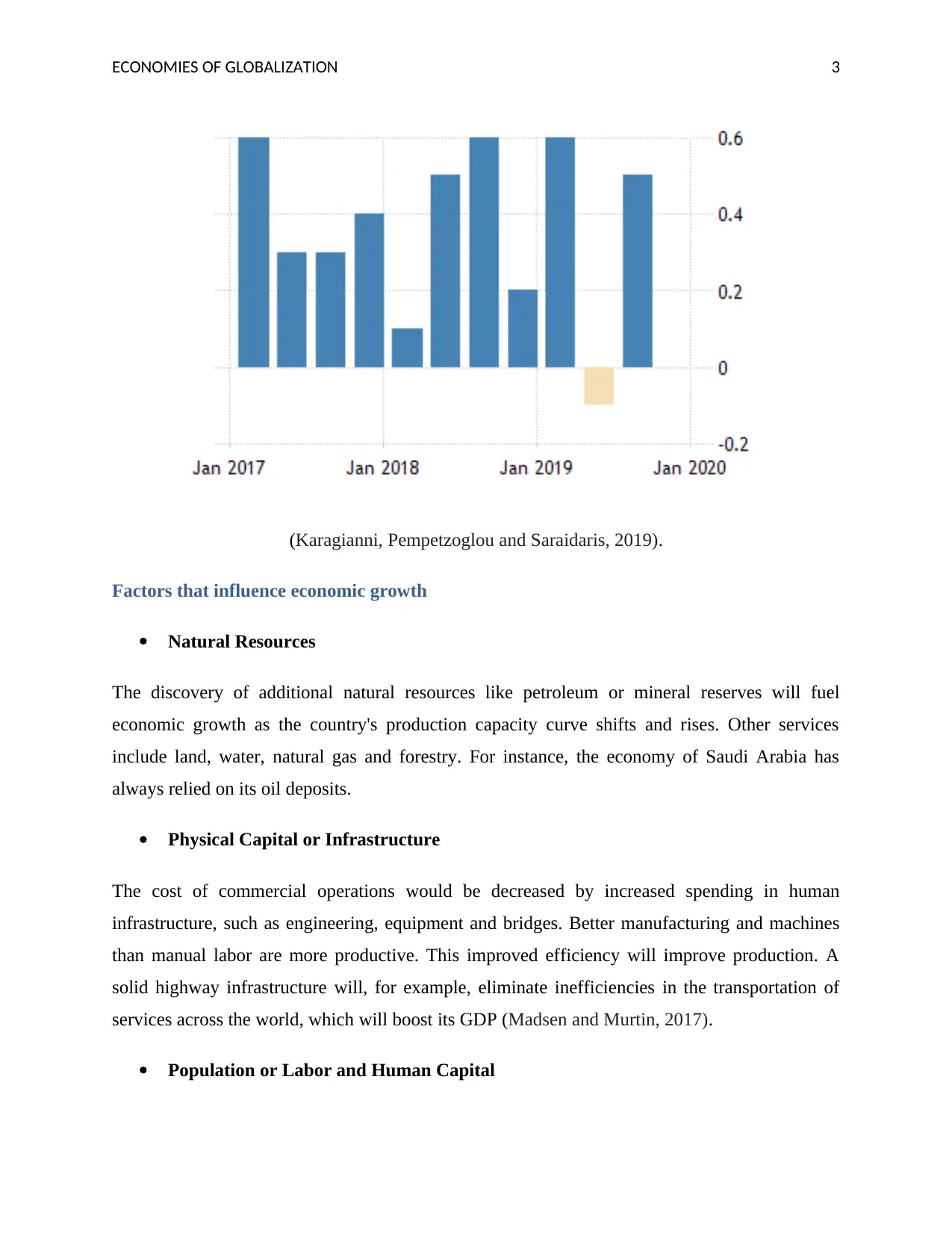
ECONOMIES OF GLOBALIZATION 3
(Karagianni, Pempetzoglou and Saraidaris, 2019).
Factors that influence economic growth
Natural Resources
The discovery of additional natural resources like petroleum or mineral reserves will fuel
economic growth as the country's production capacity curve shifts and rises. Other services
include land, water, natural gas and forestry. For instance, the economy of Saudi Arabia has
always relied on its oil deposits.
Physical Capital or Infrastructure
The cost of commercial operations would be decreased by increased spending in human
infrastructure, such as engineering, equipment and bridges. Better manufacturing and machines
than manual labor are more productive. This improved efficiency will improve production. A
solid highway infrastructure will, for example, eliminate inefficiencies in the transportation of
services across the world, which will boost its GDP (Madsen and Murtin, 2017).
Population or Labor and Human Capital
(Karagianni, Pempetzoglou and Saraidaris, 2019).
Factors that influence economic growth
Natural Resources
The discovery of additional natural resources like petroleum or mineral reserves will fuel
economic growth as the country's production capacity curve shifts and rises. Other services
include land, water, natural gas and forestry. For instance, the economy of Saudi Arabia has
always relied on its oil deposits.
Physical Capital or Infrastructure
The cost of commercial operations would be decreased by increased spending in human
infrastructure, such as engineering, equipment and bridges. Better manufacturing and machines
than manual labor are more productive. This improved efficiency will improve production. A
solid highway infrastructure will, for example, eliminate inefficiencies in the transportation of
services across the world, which will boost its GDP (Madsen and Murtin, 2017).
Population or Labor and Human Capital
Paraphrase This Document
Need a fresh take? Get an instant paraphrase of this document with our AI Paraphraser
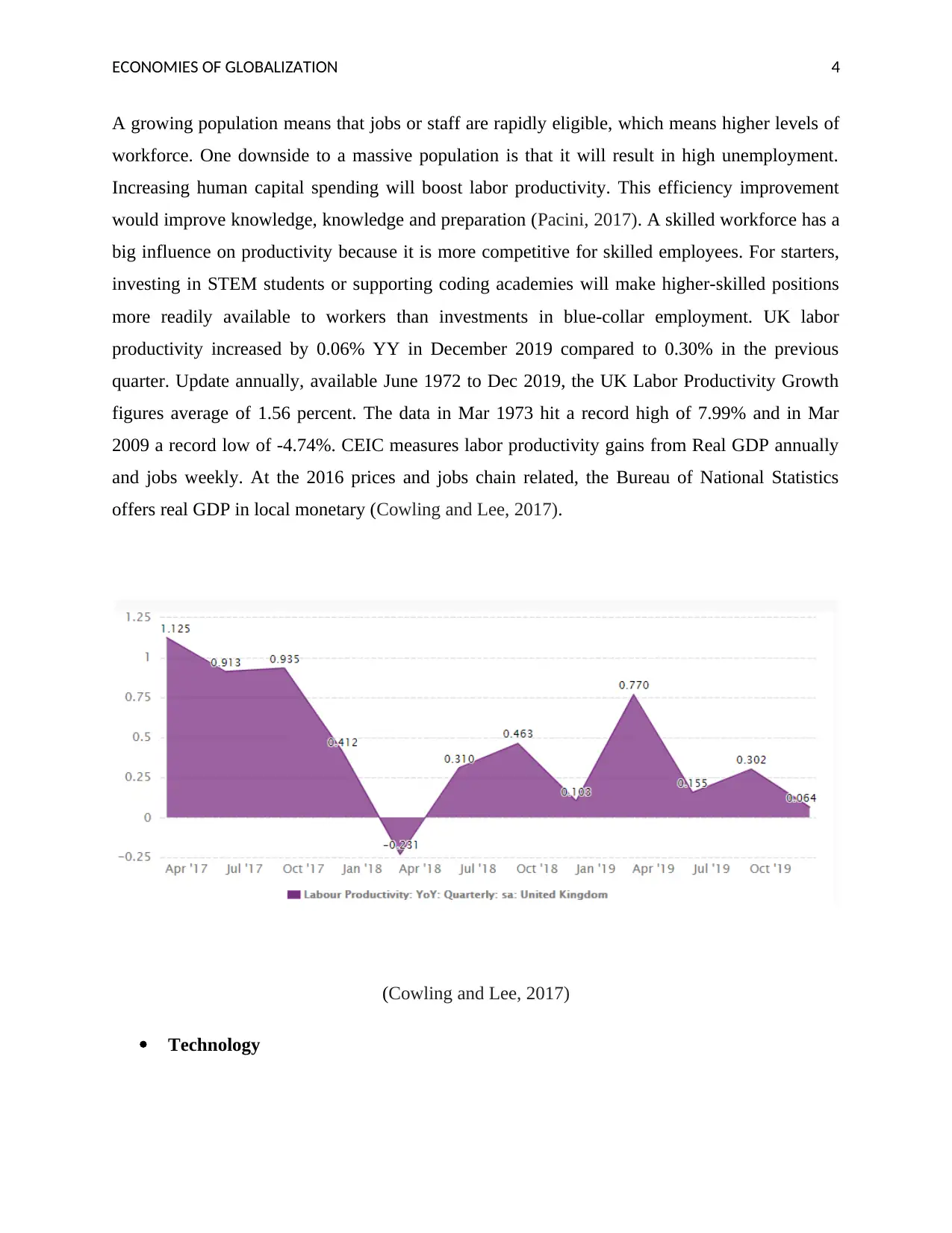
ECONOMIES OF GLOBALIZATION 4
A growing population means that jobs or staff are rapidly eligible, which means higher levels of
workforce. One downside to a massive population is that it will result in high unemployment.
Increasing human capital spending will boost labor productivity. This efficiency improvement
would improve knowledge, knowledge and preparation (Pacini, 2017). A skilled workforce has a
big influence on productivity because it is more competitive for skilled employees. For starters,
investing in STEM students or supporting coding academies will make higher-skilled positions
more readily available to workers than investments in blue-collar employment. UK labor
productivity increased by 0.06% YY in December 2019 compared to 0.30% in the previous
quarter. Update annually, available June 1972 to Dec 2019, the UK Labor Productivity Growth
figures average of 1.56 percent. The data in Mar 1973 hit a record high of 7.99% and in Mar
2009 a record low of -4.74%. CEIC measures labor productivity gains from Real GDP annually
and jobs weekly. At the 2016 prices and jobs chain related, the Bureau of National Statistics
offers real GDP in local monetary (Cowling and Lee, 2017).
(Cowling and Lee, 2017)
Technology
A growing population means that jobs or staff are rapidly eligible, which means higher levels of
workforce. One downside to a massive population is that it will result in high unemployment.
Increasing human capital spending will boost labor productivity. This efficiency improvement
would improve knowledge, knowledge and preparation (Pacini, 2017). A skilled workforce has a
big influence on productivity because it is more competitive for skilled employees. For starters,
investing in STEM students or supporting coding academies will make higher-skilled positions
more readily available to workers than investments in blue-collar employment. UK labor
productivity increased by 0.06% YY in December 2019 compared to 0.30% in the previous
quarter. Update annually, available June 1972 to Dec 2019, the UK Labor Productivity Growth
figures average of 1.56 percent. The data in Mar 1973 hit a record high of 7.99% and in Mar
2009 a record low of -4.74%. CEIC measures labor productivity gains from Real GDP annually
and jobs weekly. At the 2016 prices and jobs chain related, the Bureau of National Statistics
offers real GDP in local monetary (Cowling and Lee, 2017).
(Cowling and Lee, 2017)
Technology
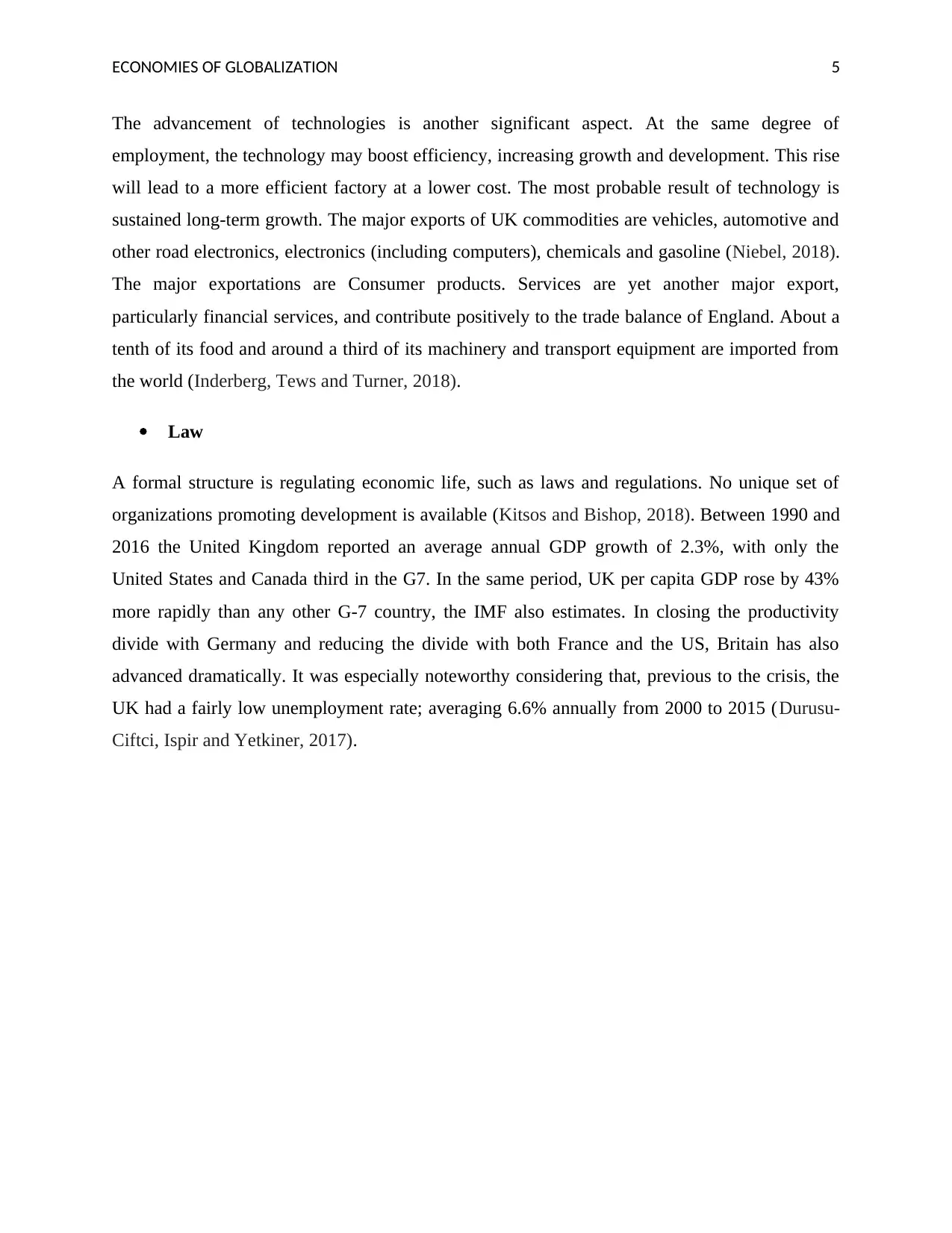
ECONOMIES OF GLOBALIZATION 5
The advancement of technologies is another significant aspect. At the same degree of
employment, the technology may boost efficiency, increasing growth and development. This rise
will lead to a more efficient factory at a lower cost. The most probable result of technology is
sustained long-term growth. The major exports of UK commodities are vehicles, automotive and
other road electronics, electronics (including computers), chemicals and gasoline (Niebel, 2018).
The major exportations are Consumer products. Services are yet another major export,
particularly financial services, and contribute positively to the trade balance of England. About a
tenth of its food and around a third of its machinery and transport equipment are imported from
the world (Inderberg, Tews and Turner, 2018).
Law
A formal structure is regulating economic life, such as laws and regulations. No unique set of
organizations promoting development is available (Kitsos and Bishop, 2018). Between 1990 and
2016 the United Kingdom reported an average annual GDP growth of 2.3%, with only the
United States and Canada third in the G7. In the same period, UK per capita GDP rose by 43%
more rapidly than any other G-7 country, the IMF also estimates. In closing the productivity
divide with Germany and reducing the divide with both France and the US, Britain has also
advanced dramatically. It was especially noteworthy considering that, previous to the crisis, the
UK had a fairly low unemployment rate; averaging 6.6% annually from 2000 to 2015 (Durusu-
Ciftci, Ispir and Yetkiner, 2017).
The advancement of technologies is another significant aspect. At the same degree of
employment, the technology may boost efficiency, increasing growth and development. This rise
will lead to a more efficient factory at a lower cost. The most probable result of technology is
sustained long-term growth. The major exports of UK commodities are vehicles, automotive and
other road electronics, electronics (including computers), chemicals and gasoline (Niebel, 2018).
The major exportations are Consumer products. Services are yet another major export,
particularly financial services, and contribute positively to the trade balance of England. About a
tenth of its food and around a third of its machinery and transport equipment are imported from
the world (Inderberg, Tews and Turner, 2018).
Law
A formal structure is regulating economic life, such as laws and regulations. No unique set of
organizations promoting development is available (Kitsos and Bishop, 2018). Between 1990 and
2016 the United Kingdom reported an average annual GDP growth of 2.3%, with only the
United States and Canada third in the G7. In the same period, UK per capita GDP rose by 43%
more rapidly than any other G-7 country, the IMF also estimates. In closing the productivity
divide with Germany and reducing the divide with both France and the US, Britain has also
advanced dramatically. It was especially noteworthy considering that, previous to the crisis, the
UK had a fairly low unemployment rate; averaging 6.6% annually from 2000 to 2015 (Durusu-
Ciftci, Ispir and Yetkiner, 2017).
⊘ This is a preview!⊘
Do you want full access?
Subscribe today to unlock all pages.

Trusted by 1+ million students worldwide
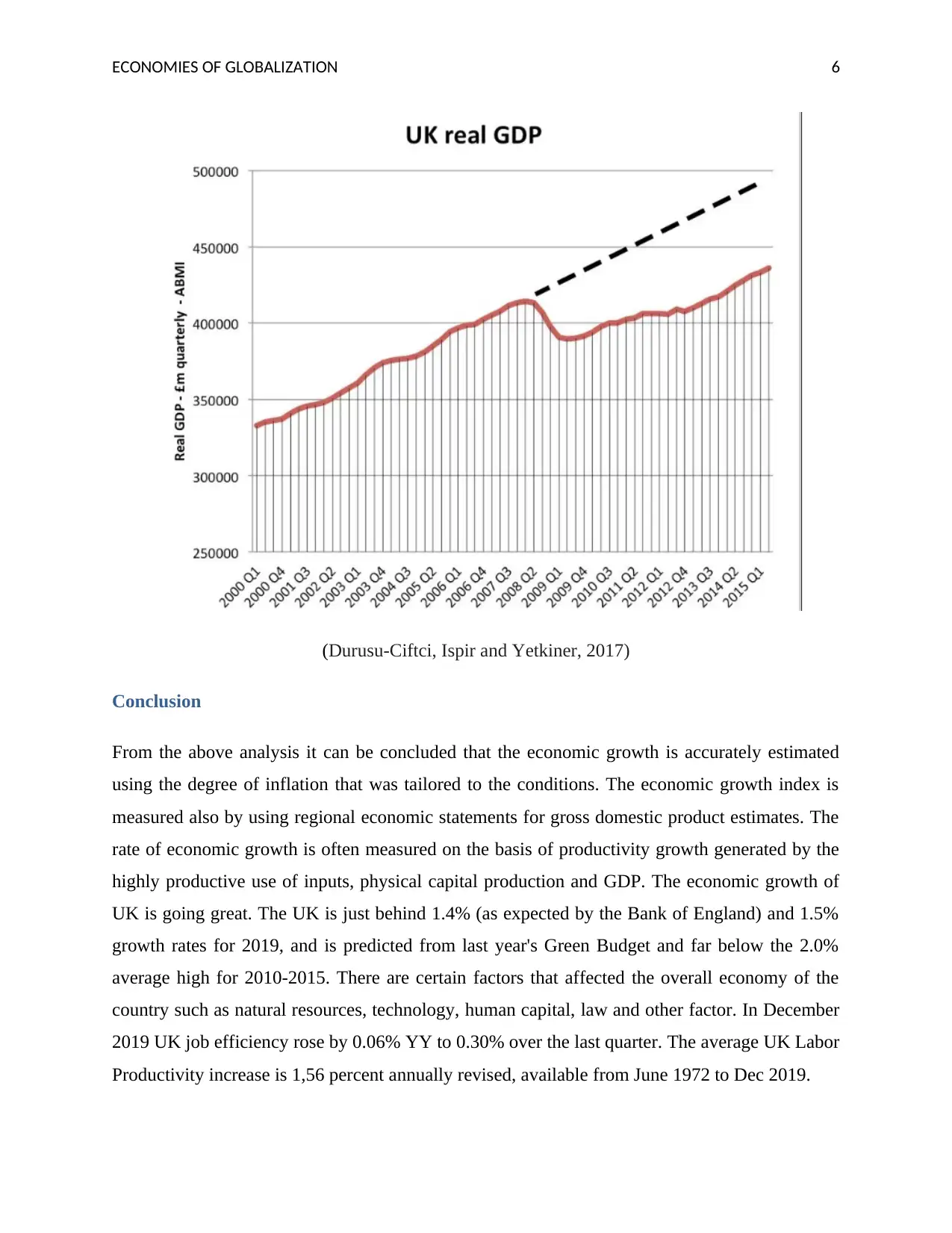
ECONOMIES OF GLOBALIZATION 6
(Durusu-Ciftci, Ispir and Yetkiner, 2017)
Conclusion
From the above analysis it can be concluded that the economic growth is accurately estimated
using the degree of inflation that was tailored to the conditions. The economic growth index is
measured also by using regional economic statements for gross domestic product estimates. The
rate of economic growth is often measured on the basis of productivity growth generated by the
highly productive use of inputs, physical capital production and GDP. The economic growth of
UK is going great. The UK is just behind 1.4% (as expected by the Bank of England) and 1.5%
growth rates for 2019, and is predicted from last year's Green Budget and far below the 2.0%
average high for 2010-2015. There are certain factors that affected the overall economy of the
country such as natural resources, technology, human capital, law and other factor. In December
2019 UK job efficiency rose by 0.06% YY to 0.30% over the last quarter. The average UK Labor
Productivity increase is 1,56 percent annually revised, available from June 1972 to Dec 2019.
(Durusu-Ciftci, Ispir and Yetkiner, 2017)
Conclusion
From the above analysis it can be concluded that the economic growth is accurately estimated
using the degree of inflation that was tailored to the conditions. The economic growth index is
measured also by using regional economic statements for gross domestic product estimates. The
rate of economic growth is often measured on the basis of productivity growth generated by the
highly productive use of inputs, physical capital production and GDP. The economic growth of
UK is going great. The UK is just behind 1.4% (as expected by the Bank of England) and 1.5%
growth rates for 2019, and is predicted from last year's Green Budget and far below the 2.0%
average high for 2010-2015. There are certain factors that affected the overall economy of the
country such as natural resources, technology, human capital, law and other factor. In December
2019 UK job efficiency rose by 0.06% YY to 0.30% over the last quarter. The average UK Labor
Productivity increase is 1,56 percent annually revised, available from June 1972 to Dec 2019.
Paraphrase This Document
Need a fresh take? Get an instant paraphrase of this document with our AI Paraphraser
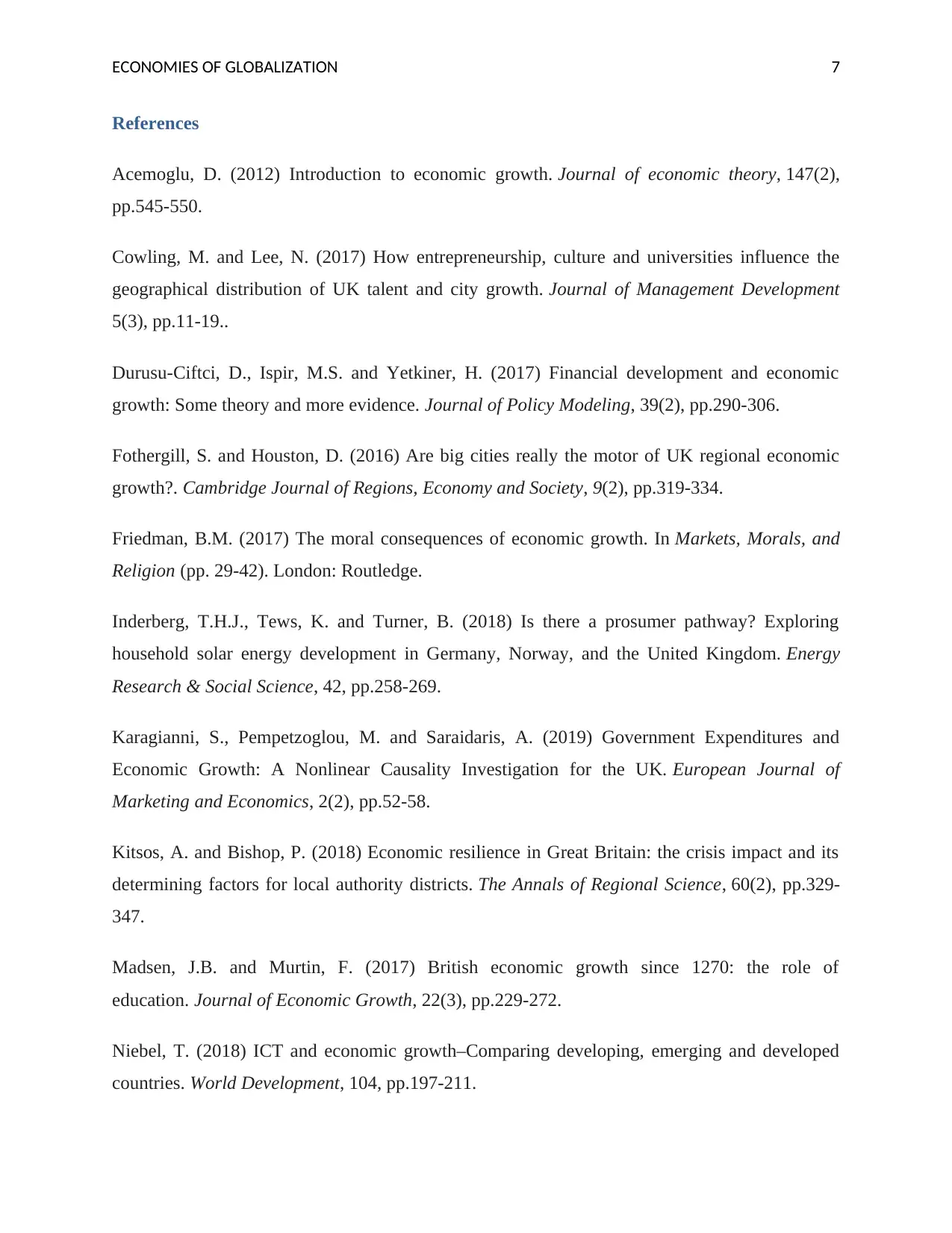
ECONOMIES OF GLOBALIZATION 7
References
Acemoglu, D. (2012) Introduction to economic growth. Journal of economic theory, 147(2),
pp.545-550.
Cowling, M. and Lee, N. (2017) How entrepreneurship, culture and universities influence the
geographical distribution of UK talent and city growth. Journal of Management Development
5(3), pp.11-19..
Durusu-Ciftci, D., Ispir, M.S. and Yetkiner, H. (2017) Financial development and economic
growth: Some theory and more evidence. Journal of Policy Modeling, 39(2), pp.290-306.
Fothergill, S. and Houston, D. (2016) Are big cities really the motor of UK regional economic
growth?. Cambridge Journal of Regions, Economy and Society, 9(2), pp.319-334.
Friedman, B.M. (2017) The moral consequences of economic growth. In Markets, Morals, and
Religion (pp. 29-42). London: Routledge.
Inderberg, T.H.J., Tews, K. and Turner, B. (2018) Is there a prosumer pathway? Exploring
household solar energy development in Germany, Norway, and the United Kingdom. Energy
Research & Social Science, 42, pp.258-269.
Karagianni, S., Pempetzoglou, M. and Saraidaris, A. (2019) Government Expenditures and
Economic Growth: A Nonlinear Causality Investigation for the UK. European Journal of
Marketing and Economics, 2(2), pp.52-58.
Kitsos, A. and Bishop, P. (2018) Economic resilience in Great Britain: the crisis impact and its
determining factors for local authority districts. The Annals of Regional Science, 60(2), pp.329-
347.
Madsen, J.B. and Murtin, F. (2017) British economic growth since 1270: the role of
education. Journal of Economic Growth, 22(3), pp.229-272.
Niebel, T. (2018) ICT and economic growth–Comparing developing, emerging and developed
countries. World Development, 104, pp.197-211.
References
Acemoglu, D. (2012) Introduction to economic growth. Journal of economic theory, 147(2),
pp.545-550.
Cowling, M. and Lee, N. (2017) How entrepreneurship, culture and universities influence the
geographical distribution of UK talent and city growth. Journal of Management Development
5(3), pp.11-19..
Durusu-Ciftci, D., Ispir, M.S. and Yetkiner, H. (2017) Financial development and economic
growth: Some theory and more evidence. Journal of Policy Modeling, 39(2), pp.290-306.
Fothergill, S. and Houston, D. (2016) Are big cities really the motor of UK regional economic
growth?. Cambridge Journal of Regions, Economy and Society, 9(2), pp.319-334.
Friedman, B.M. (2017) The moral consequences of economic growth. In Markets, Morals, and
Religion (pp. 29-42). London: Routledge.
Inderberg, T.H.J., Tews, K. and Turner, B. (2018) Is there a prosumer pathway? Exploring
household solar energy development in Germany, Norway, and the United Kingdom. Energy
Research & Social Science, 42, pp.258-269.
Karagianni, S., Pempetzoglou, M. and Saraidaris, A. (2019) Government Expenditures and
Economic Growth: A Nonlinear Causality Investigation for the UK. European Journal of
Marketing and Economics, 2(2), pp.52-58.
Kitsos, A. and Bishop, P. (2018) Economic resilience in Great Britain: the crisis impact and its
determining factors for local authority districts. The Annals of Regional Science, 60(2), pp.329-
347.
Madsen, J.B. and Murtin, F. (2017) British economic growth since 1270: the role of
education. Journal of Economic Growth, 22(3), pp.229-272.
Niebel, T. (2018) ICT and economic growth–Comparing developing, emerging and developed
countries. World Development, 104, pp.197-211.

ECONOMIES OF GLOBALIZATION 8
Pacini, K., Mayer, P., Attar, S. and Azam, J. (2017) Macroeconomic factors and firm
performance in The United Kingdom. Journal of Smart Economic Growth, 2(3), pp.1-11.
Pacini, K., Mayer, P., Attar, S. and Azam, J. (2017) Macroeconomic factors and firm
performance in The United Kingdom. Journal of Smart Economic Growth, 2(3), pp.1-11.
⊘ This is a preview!⊘
Do you want full access?
Subscribe today to unlock all pages.

Trusted by 1+ million students worldwide
1 out of 9
Related Documents
Your All-in-One AI-Powered Toolkit for Academic Success.
+13062052269
info@desklib.com
Available 24*7 on WhatsApp / Email
![[object Object]](/_next/static/media/star-bottom.7253800d.svg)
Unlock your academic potential
Copyright © 2020–2025 A2Z Services. All Rights Reserved. Developed and managed by ZUCOL.





